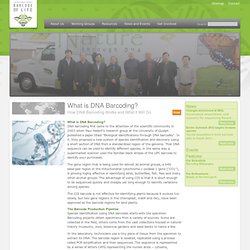

Barcode of Life « Identifying Species with DNA Barcoding. Canadian Centre for DNA Barcoding. What is DNA Barcoding? Print What is DNA Barcoding?

DNA barcoding first came to the attention of the scientific community in 2003 when Paul Hebert’s research group at the University of Guelph published a paper titled "Biological identifications through DNA barcodes". In it, they proposed a new system of species identification and discovery using a short section of DNA from a standardized region of the genome.
DNA barcoding. Applications include, for example, identifying plant leaves even when flowers or fruit are not available, identifying insect larvae (which may have fewer diagnostic characters than adults and are frequently less well-known), identifying the diet of an animal, based on its stomach contents or faeces[5] and identifying products in commerce (for example, herbal supplements or wood).[2] Choice of locus[edit] A desirable locus for DNA barcoding should be standardized (so that large databases of sequences for that locus can be developed),[6] present in most of the taxa of interest and sequenceable without species-specific PCR primers,[6] short enough to be easily sequenced with current technology,[7] and provide a large variation between species yet a relatively small amount of variation within a species.[8] Although several loci have been suggested, a common set of standardized regions were selected by the respective communities:
